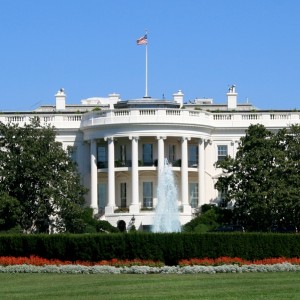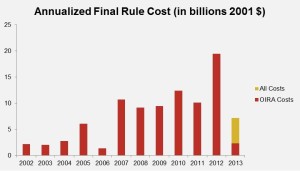An obscure report from the White House recently conceded that FY 2012 was the costliest year ever for federal regulation. This may not come as a surprise to many, but to hear it from the administration is an oddity. According to the report, “The highest benefit year was 2007 and the highest cost year was 2012.” To give some perspective, in FY 2012 the administration finalized $19.5 billion in regulatory burdens … in 2001 dollars. In today’s money, that’s about $25.7 billion.
What’s behind these figures is more illustrative and casts further doubt on numbers repeatedly trumpeted by administration after administration. Every White House figure tallies only major regulations with monetized costs and benefits exceeding $100 million. In 2012, there were just 14 major rules that monetized both costs and benefits, or less than one-half of one percent of all regulations issued during that period.
A rational audit of the regulatory state might want to include every rulemaking that monetized costs. If one includes a full accounting, that $25.7 billion figure from 2012 becomes $38.6 billion. Add in the new tax burdens from the fiscal cliff deal ($27 billion), and the total federal imposition on the economy reaches $52.7 billion. That equates to $167 for every man, woman, and child in the U.S., hardly a trivial amount in the midst of a mediocre economic recovery.
The recently released figures for 2013 paint yet another picture of under-reported costs. For this report, the White House monetized just seven rules out of more than 3,300, less than two-tenths of one percent. As a result, the administration reported costs at their lowest level since FY 2006, at just $2.3 billion (in 2001 dollars).
However, if one included all regulations containing costs, not just seven, the actual figure would be $7.2 billion ($9.1 billion in today’s dollars). Thus, the White House underreported costs by more than 300 percent, hardly a trivial error.
What can the nation expect from the next report that the administration releases on some future Friday evening? In short, costs will easily dwarf the 2013 report. The administration is slated to finalize six major energy efficiency regulations in the coming months. Those rules might sound benign, but the average efficiency standard in 2014 has imposed more than $330 million in annual costs and promises to raise prices for consumers and small businesses. If you have recently purchased a refrigerator ($83 more expensive thanks to regulation), washing machine ($108), or an automobile ($3,100), you too will have unknowingly paid a regulatory tax that often remains unseen in our economy.
Rather than slowing the pace of new rules that drive up prices, there is an acknowledged push for more in the President’s “Year of Action.” Food will become more expensive through redundant calorie labels; energy prices will increase by more than six percent by 2020 due to additional regulation of power plants; and, another round of vehicle efficiency rules will add costs to businesses and consumers.
The administration can put a price tag on the costs and benefits of these rules, but so much of regulatory action is unseen, hidden from consumers, and often, even the regulators issuing the rules. Although it might take some rules years to become final, once in place, they can remain for generations. As President Reagan once remarked, “The nearest thing to eternal life we will ever see on this earth is a government program.”
The nation can take some solace knowing that we do have a report that captures less than one percent of federal rules. The other 99 percent find their way into our pocketbooks, vehicle prices, and a business’s bottom line.


